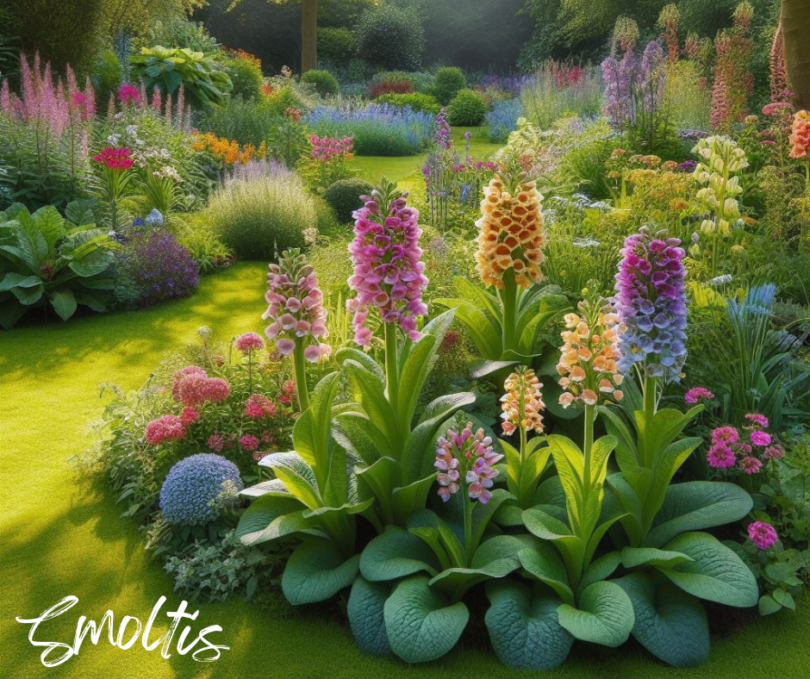Lungworts are a group of early-blooming perennial plants that thrive in shaded areas of the garden. These versatile flowers offer vibrant color and attractive foliage, making them a popular choice for adding visual interest to spaces with limited sunlight. With a wide range of cultivars available, lungworts can bring a touch of beauty to even the darkest corners of your outdoor space. In this comprehensive guide, we’ll explore the unique characteristics of lungworts and discover why they are the perfect addition to any shade-loving garden.

Key Takeaways
- Lungworts are perennial plants that flourish in shaded areas of the garden.
- These versatile flowers offer a range of vibrant colors and unique foliage patterns.
- Lungworts can thrive in even the darkest corners of your outdoor space.
- With a wide variety of cultivars, lungworts can be a versatile addition to any shade garden.
- Lungworts are an ideal choice for adding color and texture to shaded areas of your garden.
Introducing Lungworts: Shade-Loving Beauties
Lungworts, also known as Pulmonaria, are a genus of perennial flowering plants that are native to Europe and parts of Asia. These plants are known for their distinctive, mottled foliage and clusters of colorful blooms that appear in early spring. Lungworts are well-suited for growing in shaded areas because they have evolved to thrive in low-light conditions, making them an ideal choice for gardeners looking to add color and texture to their shade gardens.
What are Lungworts?
Lungworts are a group of perennial plants that belong to the Boraginaceae family. They are known for their unique, tinted and mottled foliage, which can range from deep green to silvery-gray, depending on the cultivar. The plants produce clusters of small, tubular flowers in shades of blue, purple, pink, and white, which bloom in early spring, often before many other perennials.
Why Lungworts Thrive in Shaded Areas
Lungworts are well-suited for growing in shaded areas because they have adapted to thrive in low-light conditions. These plants prefer a cool, moist environment and can tolerate the shelter provided by canopies, umbrellas, or awnings. Their unique foliage patterns and early spring blooms make them a valuable addition to any shade garden, where they can add vibrant color and texture to otherwise shadowy areas.
Shade: The Perfect Growing Condition
Shade gardens offer a unique challenge for gardeners, but they also present an opportunity to cultivate a diverse and visually stunning landscape. While many traditional garden plants require full sunlight to flourish, there are a variety of shade-loving perennials, such as lungworts, that can transform a shaded area into a lush and vibrant oasis.
Shaded areas can be created by a variety of natural and man-made elements, such as trees, buildings, fences, or even large shrubs. These shaded spaces provide a cooler, more sheltered environment that can be beneficial for certain plants, offering protection from the harsh midday sun and creating a serene, tranquil atmosphere.
| Benefit of Shade | Description |
|---|---|
| Coolness | Shaded areas experience lower temperatures, providing a respite from the intense sunlight and heat. |
| Shelter | Shaded spaces are often protected from the elements, such as strong winds and heavy rainfall, creating a more sheltered environment. |
| Reduced Evaporation | With less direct sunlight, the soil in shaded areas retains moisture for longer, reducing the need for frequent watering. |
| Unique Aesthetics | Shaded gardens can have a serene, tranquil atmosphere, with tinted and dappled light creating a visually striking environment. |
By embracing the challenges of shade and incorporating shade-loving plants like lungworts, gardeners can create a lush and inviting oasis that offers a respite from the harsh sunlight and heat.
Lungwort Varieties to Brighten Up Shady Spots
Lungworts come in a wide variety of cultivars, each with its own unique characteristics and visual appeal. Some of the most popular and widely-grown lungwort varieties for shaded gardens include:
Virginia Bluebells
The Virginia bluebell, also known as Mertensia virginica, is a striking lungwort variety with delicate, bell-shaped blue flowers that bloom in early spring. These shade-loving plants thrive in the cool, sheltered environments provided by canopies and umbrellas, creating a stunning display against the backdrop of their mottled, tinted foliage.
Bethlehem Sage
Bethlehem sage, or Pulmonaria officinalis, is a classic lungwort cultivar known for its shaded silver-and-green patterned leaves and clusters of pink, blue, and purple flowers. This versatile plant adapts well to a variety of shady conditions, making it an excellent choice for adding coolness and texture to any sheltered garden space.
Barrenwort
Barrenwort, or Epimedium, is a unique lungwort variety that thrives in shaded areas, offering delicate, colorful blooms and attractive, tinted foliage. These plants are particularly well-suited for growing under canopies and awnings, where they can add a touch of whimsy and coolness to the shaded landscape.
| Variety | Bloom Time | Foliage | Light Preferences |
|---|---|---|---|
| Virginia Bluebells | Early Spring | Mottled, tinted leaves | Partial to full shade |
| Bethlehem Sage | Spring | Silver-and-green patterned leaves | Partial to full shade |
| Barrenwort | Spring | Tinted, delicate foliage | Partial to full shade |
Planting and Caring for Lungworts
When it comes to growing lungworts, it’s important to provide the right growing conditions to ensure their success. Lungworts prefer well-draining, nutrient-rich soil that is slightly acidic, with a pH range of 5.5 to 6.5. They thrive in the cool, moist environments found in shaded areas, making them an ideal choice for areas with limited direct sunlight.
Ideal Soil Conditions
To create the perfect environment for lungworts, amend your soil with compost or well-rotted organic matter, which will help to improve drainage and provide the necessary nutrients. Lungworts prefer a slightly acidic soil, so consider adding sulfur or peat moss to lower the pH if needed.
Watering Requirements
Consistent moisture is key for healthy lungworts. Water your plants regularly, especially during dry spells, to keep the soil consistently moist but not waterlogged. Avoid letting the soil dry out completely, as this can stress the plants and lead to problems. In shaded areas, the canopy and shelter provided by trees or structures can help retain coolness and moisture, making them ideal for growing lungworts.
Pruning and Maintenance
Lungworts require minimal pruning, but it’s a good idea to deadhead spent flowers and remove any damaged or diseased foliage to keep the plants looking their best. This can be done with a pair of sharp, clean shears or scissors. Additionally, consider providing shade or an umbrella-like awning to protect the plants from harsh sunlight and shadows during the hottest parts of the day, ensuring their continued vigor and vibrant tint.
Designing a Shaded Garden with Lungworts
When planning a shade garden, it’s crucial to consider how to create depth, texture, and visual interest. Lungworts can play a key role in achieving this harmonious balance. These versatile perennials not only thrive in shaded areas but also seamlessly complement a variety of companion plants, helping to craft a captivating and cohesive garden design.
Companion Plants for Shade Gardens
Lungworts pair beautifully with other shade-loving plants, creating a lush and inviting canopy of foliage and tints. Consider incorporating woodland-inspired plants, such as ferns, hostas, and hellebores, to enhance the coolness and shelter of the shaded area. Additionally, incorporating small-scale shrubs or umbrellas can provide additional shade and awning to the garden, further emphasizing the shadows and shading that lungworts thrive in.
Creating Depth and Texture
Lungworts’ unique foliage patterns and varied bloom colors can add remarkable depth and texture to a shade garden. By layering different cultivars with contrasting leaf shapes, sizes, and tints, you can create a visually captivating tapestry that draws the eye deeper into the garden. Incorporating taller plants, such as flowering perennials or small trees, can also help to establish a sense of depth and dimension, while lower-growing ground covers and trailing vines can fill in the shadows and shaded areas, creating a lush and inviting canopy.
Lungworts: Nature’s Shade-Loving Gems
Lungworts are truly nature’s gems when it comes to shaded garden spaces. Their unique foliage patterns and early spring blooms make them a standout choice for adding visual interest and color to these often-overlooked areas.
Unique Foliage Patterns
One of the most distinctive features of lungworts is their captivating foliage. The leaves often display a mottled pattern of shades and tints, creating a striking contrast that adds depth and texture to the shade-loving plants. This canopy of coolness and shelter provided by the unique foliage can transform even the darkest corners of the garden into a visually stunning oasis.
Early Spring Blooms
As the sunlight begins to peek through the shadows and shading of early spring, lungworts burst forth with a stunning display of vibrant blooms. These umbrella-like flowers can range in color from delicate pinks and purples to deep, rich blues, adding a pop of coolness to the garden before many other plants have even awakened.
The combination of lungworts’ distinctive foliage and their early spring blooms makes them a true delight for gardeners seeking to bring life and color to their shade-filled outdoor spaces.
Shade Gardening Tips and Tricks
Gardening in shaded areas can present unique challenges, but with the right strategies, you can create a thriving, visually stunning shade garden. One key consideration is maximizing the available light exposure.
Maximizing Light Exposure
In shaded areas, it’s important to carefully consider the placement of your plants to ensure they receive the optimal amount of sunlight. Strategically positioning lungworts and other shade-loving perennials near reflective surfaces, such as tinted glass or mirrored accents, can help to bounce light and create the illusion of a brighter space.
Additionally, incorporating canopies, umbrellas, or awnings can provide a controlled amount of shade while still allowing for the necessary sunlight to reach your plants. By carefully balancing the shelter and coolness provided by these elements, you can create a harmonious and thriving shade garden.
Incorporating Hardscaping Elements
Hardscaping features, such as stone pathways, brick walls, or wooden structures, can also play a crucial role in enhancing the overall aesthetic and functionality of a shade garden. These elements can not only provide visual interest and texture but also help to define the space, creating a sense of shelter and coolness.
By thoughtfully incorporating hardscaping elements, you can strategically manipulate the shadows and shading in your garden, ensuring that your lungworts and other shade-loving plants thrive in their preferred growing conditions.
Lungworts: A Seasonal Delight
Lungworts are a true delight for gardeners throughout the seasons. In early spring, their vibrant blooms and attractive foliage provide a burst of color and texture to shaded areas, heralding the arrival of warmer weather. As the year progresses, the lungworts’ foliage remains lush and visually appealing, even as the flowers fade.
The versatility of lungworts shines through their ability to adapt to changing sunlight conditions. While they thrive in the coolness and shelter of shaded areas, they can also tolerate moderate sunlight exposure, making them a versatile choice for a variety of garden settings. Their mottled tint and canopy-like leaves add depth and interest to the landscape, even when the blooms have passed.
Whether you’re seeking to create a lush, shaded oasis or complement a mixed border with their eye-catching presence, lungworts are a seasonal delight that will captivate your garden from spring to fall. Their resilience and adaptability make them a must-have for any gardener looking to bring a touch of coolness and shelter to their outdoor umbrella or awning-covered spaces.
Conclusion
Lungworts are truly remarkable perennials that are ideally suited for shaded gardens. With their vibrant blooms, distinctive foliage, and ability to thrive in low-light conditions, these versatile plants can transform even the darkest corners of your outdoor space into a lush, colorful oasis. Whether you’re looking to add a pop of color to a shaded nook or create a serene and tranquil atmosphere, lungworts are the perfect choice to bring life and vitality to your shade-loving garden.
By understanding the unique needs and characteristics of lungworts, gardeners can unlock the true potential of these shade-thriving beauties. From selecting the right cultivars to providing the optimal growing conditions, incorporating lungworts into your landscape design can elevate the visual interest and overall ambiance of your shaded areas. As you continue to explore the world of shade gardening, let lungworts be your guide to creating a truly remarkable and flourishing outdoor haven.
With their ability to thrive in shadows and shading, lungworts offer a versatile solution for gardeners looking to bring coolness and shelter to their outdoor spaces. Whether you’re faced with a canopy of sunlight or a cozy umbrella of tint, these remarkable plants can effortlessly adapt and contribute to the overall awning of your shaded garden.
FAQ
What are Lungworts?
Lungworts, also known as Pulmonaria, are a genus of perennial flowering plants that are native to Europe and parts of Asia. These plants are known for their distinctive, mottled foliage and clusters of colorful blooms that appear in early spring.
Why do Lungworts thrive in shaded areas?
Lungworts are well-suited for growing in shaded areas because they have evolved to thrive in low-light conditions. Their ability to adapt to shaded environments makes them an ideal choice for gardeners looking to add color and texture to their shade gardens.
What are some popular Lungwort varieties for shaded gardens?
Some of the most popular and widely-grown Lungwort varieties for shaded gardens include Virginia Bluebells, Bethlehem Sage, and Barrenwort.
What soil conditions do Lungworts prefer?
Lungworts prefer well-draining, nutrient-rich soil that is slightly acidic, with a pH range of 5.5 to 6.5. They thrive in the cool, moist environments found in shaded areas.
How can Lungworts be used in shade garden design?
Lungworts can be seamlessly integrated into a variety of shade garden designs. They can help create depth, texture, and visual interest, especially when paired with complementary companion plants.
What are the unique features of Lungworts?
Lungworts are known for their distinctive foliage patterns and early spring blooms, which make them a standout choice for adding color and visual interest to shaded garden spaces.
How can gardeners maximize light exposure in a shaded garden?
One key consideration for gardening in shaded areas is maximizing the available light exposure. This can be achieved through strategic placement of hardscaping elements, such as trellises or screens, to help reflect and direct the available sunlight.
How do Lungworts perform throughout the seasons?
Lungworts are a true delight for gardeners throughout the seasons. In early spring, their vibrant blooms and attractive foliage provide a burst of color and texture, and their lush foliage remains visually appealing even as the flowers fade.







